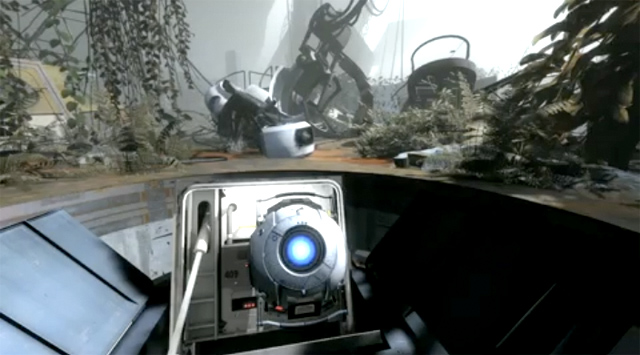
I have a huge confession to make: Portal was a good game.
There, I said it. Not a great game, not the best game of the year, and certainly not the eye-opening experience that many made it out to be… at least to me it wasn’t. While it introduced a wonderful gameplay mechanic and an unforgettable cast and plot, I felt that tank-like controls and the lack of some physical detail — the Companion Cube just “floated” in front of me when I picked it up, instead of showing my hands or shadows — were enough to take me out of the experience. Not by much, but by enough.
Please give me a moment to duck from the tomatoes being thrown my way, because I’m about to turn into a reformist:
Portal 2 was the best game at this year’s E3.
When we arrived at Valve’s “secret room” hidden in the farthest corner of West Hall, the collection of games journalists that greeted us looked like a line-up of expectant father’s in a delivery room. Beads of sweat trickled down brows as the anticipation for the Messiah-like rebirth of GLaDOS was imminently near. We were soon ushered into an even smaller, more compact room, where we were treated to an almost Dharma Initiative extended trailer for the game. We realized quickly that Portal was back, and its magic had been amplified by exponential amounts.

The game is set years after the end of the original. GLaDOS, the malevolent mechanical mistress, is rebuilding the chambers, making improvements and spawning new traps tools. The poor thing only knows how to interact with us humans by testing us, we’re told. GLaDOS, intent on revenge, maintains the same sly sarcasm that she was famous for, insisting that she be allowed to reengage with our hero/lab rat “for science”.
As the pre-recorded trailer rolled on, the visuals looked much more crisp and glossy and the rooms much bigger and detailed, as Portal moves on from development by a small Indie team to full AAA title treatment. The spectacular lighting effects around the new weapons and tools highlighted the emphasis on a more vibrant, living environment. The portals themselves were no longer flat 2-D objects; they now shimmered and emitted little blobs of light. Also visible was the lush overgrowth of the setting, as vines, weeds, and plants have overrun Aperture Science. I half-expect to see some wildlife running around as well.

Portal, built around a novel “weapon” and an FPS perspective, was at times purposefully repetitive. Some of the stage designs were too similar, and often the joy of puzzle-solving dissipated into “when will I get the hell out of this room.” Portal 2 resolves that by implementing several new tools to help (and hamper) along the way. The Excursion Funnels, Aerial Faith Plates (platforms that launch users into the air), Thermal Discouragement Beams (an “always on” deadly laser), and the vacuum-like Pneumatic Diversity Vents are not only smartly named, but also add proportional levels of problem solving that needed to take place. The joy is in their combination, as the elements can create a Rube Goldberg machine to reach the goal.
My personal favorite new tools are the ones that Hero would have direct control of: the gels. Sprayed onto the floor, walls, or objects, the gels amplify specific actions. The Repulsion Gel allows for higher jumps, while the Propulsion Gel increases run speed.
The most engaging addition to Portal 2 may be the new side-kick, Wheatley. Wheatley, a “personality core”, has become sentient and has been trying to escape from GLaDOS since the collapse of the lab. The writing for the character is brilliant, as Wheatley comes off as a likable know-it-all, much like an English club-goer finding the perfect night club to drink expensive martinis. “Oh no, avoid eye contact, they’ll never shut up” he decries when passing a turret. The room full of sweaty journalists erupts in laughter. Even with those short 10 minutes in the demo room, Wheatley may be one of the most memorable video game characters to date.
One important point to note is that the original Portal, though a “core” game, was accessible to players of any ability. If a puzzle was attempted enough, the player would eventually figure out the solution. With Portal 2, the developers do not want the game to be harder, but want the puzzles to require more thinking. It’s this type of design that makes the game that much more appealing to me. I won’t be throwing any controllers, I may just set them down for a day. And for that, Valve is creating more than just a sequel… they’re creating a legacy.


2 Comments